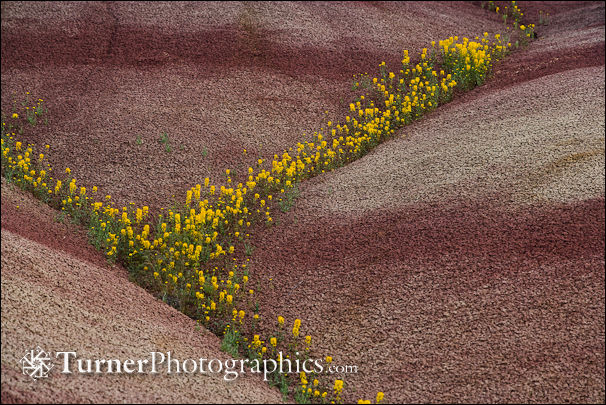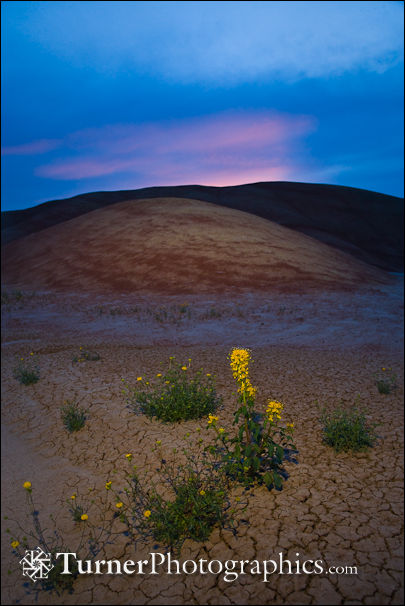Paint the Hills Red

The Painted Hills in the John Day Fossil Beds National Monument in north-central Oregon are an out-of-this-world landscape. Layers of colorful bentonite, formed from ancient volcanic ash, change color with the light and moisture content. Each spring they pick up golden highlights from two endemic plants. The taller of the two, Golden Bee Plant or Cleome platycarpa, is an annual with a bright tuft of flowers at the top. The other, John Day’s Pincushion or Chaenactis nevii, is also an annual.
The number of plants that grow and bloom each year is the result of a combination of conditions, but especially how much rain falls and when it comes. The bentonite clay of the hills where these two grow is particularly inhospitable to plants. When it gets wet it absorbs water and expands. As it dries out it shrinks and forms a nearly impenetrable layer. Seeds have a hard time getting started in the stuff.
At the Painted Hills you see most of the flowers in the folds of the hills, small watercourses that accumulate bits of organic matter that mix with the clay, and on the outwash plains at the base. Here the conditions are just a little bit friendlier to plant growth.

The day I visited the Painted Hills the park ranger, Scott Ritner, was leading a photographer’s walk up to the base of the hills timed for the evening light. Unfortunately the sky was a dreary overcast as three other photographers and I headed up the dry wash behind the barbed wire fence with Scott. Most of the time visitors are prohibited from getting too close to the hills because human footprints on the delicate clay surface last 3-4 years before erosion washes them away. Scott pointed to antelope tracks and said they’d be gone in about a year.
 As we were walking back to our cars the sky briefly lit up with a hint of pink over the hills and we all stopped to grab a quick sunset shot. I pulled out my flash and off-camera cord and made a series of exposures lighting up the foreground and the nearest hill to balance with the sky. Without the foreground illumination the bee plant disappeared into the gray mush of the dim light. I set the flash to about minus 1 1/3 stops and held it above and to camera left.
As we were walking back to our cars the sky briefly lit up with a hint of pink over the hills and we all stopped to grab a quick sunset shot. I pulled out my flash and off-camera cord and made a series of exposures lighting up the foreground and the nearest hill to balance with the sky. Without the foreground illumination the bee plant disappeared into the gray mush of the dim light. I set the flash to about minus 1 1/3 stops and held it above and to camera left.
All three of these photos have had their contrast and saturation enhanced a bit in Adobe Lightroom and the one at the top got a little treatment with Topaz Adjust as well to compensate for the very flat light. I expected to make those adjustments at the time I made the exposures. The top two photos were made with a 70-200mm lens and the bottom one with a 24-105 zoomed most of the way out.
You can see more photos from the Painted Hills on my Pacific Northwest Wildflowers website. The gallery includes other flowers photographed along the back roads between the Clarno and Painted Hills units of the monument. The Painted Hills are at the end.


Wow. Gorgeous, Mark! Good job.
Wish I could have been there. Have heard about that area of Oregon and now really want to see more. Thanks for the posting.
Saxon, the east side of Oregon has so much to offer. It’s radically different from what most folks think of about Oregon. I love visiting down there and wish I could spend even more time poking around the back roads.